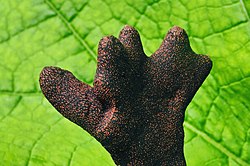Top Qs
Timeline
Chat
Perspective
Xylaria polymorpha
Species of fungus From Wikipedia, the free encyclopedia
Remove ads
Xylaria polymorpha, commonly known as dead man's fingers, is a cosmopolitan saprobic fungus. It is characterized by its elongated upright, clavate, or strap-like stromata poking up through the ground, much like fingers.
Remove ads
Taxonomy
The genus Xylaria contains about 100 species of cosmopolitan fungi. The specific epithet polymorpha means "many forms". As its name suggests, it has a variable but often club-shaped fruiting body (stroma) resembling burned wood.[1]
Description
Summarize
Perspective
Belonging to the phylum of fungus known as Ascomycetes (division Mycota) known as the sac fungi, they are characterized by a saclike structure, the ascus, which contains anything from four to eight ascospores in the sexual stage. The sac fungi are separated into subgroups based on whether asci arise singly or are borne in one of several types of fruiting structures, or ascocarps, and on the method of discharge of the ascospores. Unlike some species in this class, X. polymorpha is inedible.[2]
Often this fungus is found with a multitude of separate "digits", but at times the individual parts will be fused together. In maturity, the fruiting bodies can be 3–10 centimetres (1+1⁄4–4 inches) tall, externally colored black or brown,[3] sometimes with shades of blue or green. It is white on the inside, with a blackened dotted area all around. This blackened surrounding area is made up of tiny structures called perithecia. The perithecia hold a layer of asci which contain the ascospores. The asci elongate into the ostiole, and discharge the ascospores outward. The spore distribution is a lengthy process, sometimes taking several months to complete. The spore print is black.[3]
In springtime this fungus often produces a layer of white or bluish asexual spores called conidia, which grow on its surface and surrounding area.[4]
Remove ads
Distribution and habitat
X. polymorpha is geographically distributed across all six inhabited continents.[5] It is a common inhabitant of forest and woodland areas, usually growing from the bases of rotting or injured tree stumps and decaying wood. It has also been known to colonize substrates like woody legume pods, petioles, and herbaceous stems.[4]
References
External links
Wikiwand - on
Seamless Wikipedia browsing. On steroids.
Remove ads


